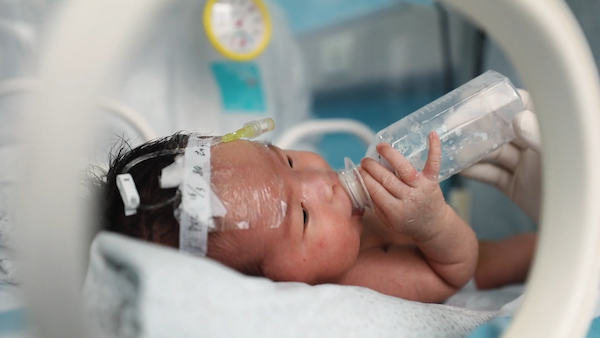More a document than a documentary, 76 Days unfolds in the ICU units and critical care wards of hospitals in Wuhan, China, ground zero for the Covid-10 outbreak. Filmed on the fly, the film captures the hysteria and desperation of patients and caregivers on the brink of a pandemic.

Opening titles explain that 11 million people lived in Wuhan on January 23, 2020, when filming started. Drone shots show eerily empty city streets. We glimpse barricaded streets and alleyways, guards at checkpoints, ambulances speeding by. But almost all of 76 Days takes place within hospitals and medical facilities.
Directors Hao Wu and Weixi Chen structure their documentary like a horror movie, one about a zombie apocalypse with no cure or solution in sight. Handheld cameras chase after nurses in haz-mat suits running down corridors. Workers guard a door to an entryway filled with people pushing and screaming for food and beds. “Too much chaos,” a nurse warns them. “Step back.”
A nurse complains on a phone that her ward is full, turning away more patients as the dead are wheeled out in body bags on stretchers. A puzzled worker asks Doctor Wang what to do for a patient when she has no intubation equipment. Children and grandchildren call down corridors, prohibited from visiting the dying.
Characters gradually emerge from the chaos, like a grandfather with dementia who wanders the hallways. “He was a fisherman, so he’s always restless,” another patient says. An elderly husband and wife reassure other on cell phones. Later we learn that one has died.
The cameras focus on two nurses — Yang Li and Tian Dingyuan — on their rounds. The care they give is extraordinary, but their patients die anyway. We also see day-to-day routines: handing out food trays, calling family members with bad news, disinfecting the cellphones and IDs of the dead.
Don’t expect analysis from 76 Days. There are no talking heads, no experts, no doctors explaining what is happening. We’re not even sure where or when events take place. Scenes seem to be included just because a camera was there to record them, not because they add to our understanding of the pandemic.
Some of the imagery is shocking, like the IVs on a premature baby. More often the camerawork feels jumbled, rushed, trying to make sense of events that are already slipping by.
As the documentary proceeds, a sense of order comes to the wards. The nurses are calmer, the patients quieter. Some even return home. By the end of 76 Days, traffic has returned to the streets.
The closer the pandemic has come to your life, the more you may relate to the documentary. It’s an effective record of a harrowing experience, but only a first draft for the story of the pandemic.
76 Days screened at this year’s Toronto International Film Festival and more recently at DOC NYC.


